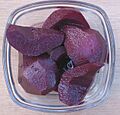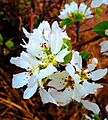Pear facts for kids
Quick facts for kids Pear |
|
|---|---|
 |
|
| European Pear branch with fruit | |
| Scientific classification | |
| Kingdom: | |
| Division: | |
| Class: | |
| Order: | |
| Family: | |
| Subfamily: | |
| Tribe: |
Maleae
|
| Subtribe: | |
| Genus: |
Pyrus
|
A pear is a tasty fruit that you can eat. It often has a unique teardrop shape. Pears are usually best when they are cool and juicy. They do not ripen very well while still on the tree. Pears can be soft in the middle when ripe.
You can enjoy pears in many ways. They can be baked, canned, or frozen. Many people also love to eat them fresh. Pears are used to make jams, jellies, and juice. They can also be put into pies, salads, or even baby food. Pears are mostly water, about 83 percent. Their skin can be green, red, yellow, or brown. Pears first came from Europe, Africa, and Asia. Pear trees like to grow in rich, heavy soil.
Pears belong to the same plant subfamily called Maloideae as apples. This subfamily is part of the Rosaceae family.
Contents
Discover the Pear Tree
The pear fruit grows on a tree called Pyrus communis. This is also known as the common pear tree. These trees can grow quite tall, from 10 to 20 meters (about 33 to 66 feet) high. They can live for about 65 years.
When young, the tree looks like a pyramid. As it gets older, it becomes more rounded. Eventually, it takes on an oval shape. The bark of this tree is gray and has many cracks. Its leaves are a dark green color and about 10 centimeters (4 inches) long. The flowers are pink or white and can be up to 1.5 centimeters (0.6 inches) long.
Pear trees need soil that is not too dry or too wet. They grow best in places with mild and humid weather. There are about 3,000 different types of pears grown around the world.
History of Pears
Pears first appeared in Eastern Europe and Western Asia. People started growing them a very long time ago, during the Stone Age. The pears we eat today are the result of different wild pear plants mixing together over time.
The Romans also grew pears. They ate the fruits raw or cooked them, just like they did with apples.
Storing and Ripening Pears
You can store pears at room temperature until they are ripe. A pear is ripe when the area around its stem feels soft if you gently press it. Once ripe, it is best to keep pears in the refrigerator. Place them uncovered in a single layer. They will stay fresh for about 2 to 3 days this way.
Pears will ripen faster if you place them near bananas in a fruit bowl. This is because bananas release a gas called ethylene which helps fruits ripen. Keeping pears in the refrigerator will slow down their ripening process.
Most pear types do not change much in color when they ripen. For example, Bartlett pears turn from green to yellow. But many others stay almost the same color. The best way to know if a pear is ripe is to "check the neck." Gently press the top part of the pear near the stem with your thumb. If it gives a little, the pear is ripe, sweet, and juicy. If it feels firm, leave it at room temperature and check it again each day.
How Pears Are Used
Pears are eaten fresh, canned, or dried. Their juice is also popular. Pear juice can be used to make jellies and jams. It is often mixed with other fruits, like berries. Fermented pear juice is called perry or pear cider. It is made in a similar way to how cider is made from apples.
Some types of pears are called "culinary" or cooking pears. These pears are green, dry, and hard. They need to be cooked for several hours before they are soft enough to eat. Two types from the Netherlands are "Gieser Wildeman" (a sweet kind) and "Saint Rémy" (a bit sour).
Pear wood is also very useful. It is a favorite material for making high-quality woodwind instruments and furniture. In the past, it was used to make carved blocks for woodcuts. Pear wood is also good for wood carving. It can be used as firewood to create a nice smell when smoking meat or tobacco. People value pear wood for kitchen tools like spoons and stirrers. This is because it does not change the color, flavor, or smell of food. It also resists bending and breaking even after getting wet and drying many times.
Related pages
Images for kids
-
Pyrus calleryana in flower
-
Many varieties, such as the Nashi pear, are not "pear-shaped".
-
Poire Williams, a fruit brandy produced from the Williams pear. The bottle is tied to the tree and the pear is grown inside of it.
See also
 In Spanish: Pyrus para niños
In Spanish: Pyrus para niños










